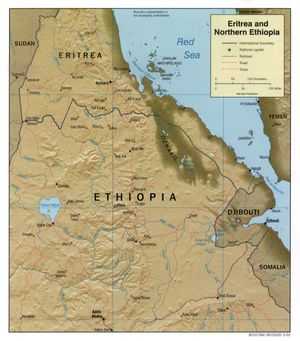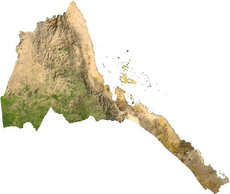Geography of Eritrea





Eritrea is located in the Horn of Africa and is bordered on the northeast and east by the Red Sea, on the west and northwest by Sudan, on the south by Ethiopia, and on the southeast by Djibouti. The country has a high central plateau that varies from 1,800 to 3,000 meters (5,906 to 9,843 ft) above sea level. A coastal plain, western lowlands, and some 350 islands comprise the remainder of Eritrea's land mass. Eritrea has no year-round rivers.
Climate
Hot, dry desert strip along Red Sea coast; cooler and wetter in the central highlands (up to 610 mm (24.0 in) of rainfall annually); semiarid in western hills and lowlands; rainfall heaviest during June–September except in coastal desert. The climate is temperate in the mountains and hot in the lowlands. Asmara, the capital, is about 2,400 meters (7,874 ft) above sea level. Maximum temperature is 26 °C (78.8 °F). The weather is usually sunny and dry, with the short or belg rains occurring February–April and the big or meher rains beginning in late June and ending in mid-September.
Data
Location: Eastern Africa, bordering the Red Sea, between Djibouti and Sudan, also bordering on Ethiopia.
Geographic coordinates: 15°00′N 39°00′E / 15.000°N 39.000°E)
Map references: Africa
Area:
total:
124 320 km²
land:
121 320 km²
water:
4000 km²
Area - comparative: slightly larger than Pennsylvania
Land boundaries:
total:
1 630 km
border countries:
Djibouti 113 km, Ethiopia 912 km, Sudan 605 km
Note that the border between Eritrea and Ethiopia is disputed.
Coastline: 2 234 km total; mainland on Red Sea 1 151 km, islands in Red Sea 1 083 km
Maritime claims: NA
Terrain: dominated by extension of Ethiopian north-south trending highlands, descending on the east to a coastal desert plain, on the northwest to hilly terrain and on the southwest to flat-to-rolling plains
Ecoregions: Most of Eritrea's coast is part of the Ethiopian xeric grasslands and shrublands semi-desert ecoregion. The southern part of the Red Sea coast, along with the Red Sea coast of Djibouti, has been described as the Eritrean coastal desert, a harsh sand and gravel coastal strip covered in dune grasses and shrubs that is important as a channel for the mass migration of birds of prey.
Elevation extremes:
lowest point:
near Lake Kulul within the Afar Depression −75 m
highest point:
Soira 3 018 m
Natural resources: gold, potash, zinc, copper, salt, possibly petroleum and natural gas, fish
Land use:
arable land:
12%
permanent crops:
1%
permanent pastures:
49%
forests and woodland:
6%
other:
32% (1998 est.)
Irrigated land: 280 km² (1993 est.)
Natural hazards: frequent droughts and locust storms
Environment - current issues: deforestation; desertification; soil erosion; overgrazing; loss of infrastructure from civil warfare; ash contamination from recent eruption of the Nabro Volcano.
Environment - international agreements:
party to:
Biodiversity, Climate Change, Desertification, Endangered Species
signed, but not ratified:
none of the selected agreements
Geography - note: strategic geopolitical position along world's busiest shipping lanes; Eritrea retained the entire coastline of Ethiopia along the Red Sea upon de jure independence from Ethiopia on 24 May 1993.
Extreme points
This is a list of the extreme points of Eritrea, the points that are farther north, south, east or west than any other location.
- Northernmost point - the point at which the border with Sudan enters the Red Sea, Northern Red Sea region
- Easternmost point - the point at which the border with Djibouti enters the Red Sea, Southern Red Sea Region
- Southernmost point - unnamed location on the border with Djibouti immediately east of the Djiboutian town of Dadda`to, Southern Red Sea Region
- Westernmost point - Abu Gamal mountain, Gash-Barka
| |||||||||||
| |||||||||||
| |||||||||||||||||||||||||||||||||||||||
.svg.png)